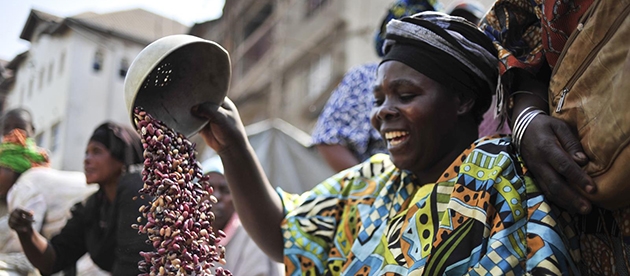HarvestPlus is one of PABRA’s many partners working to increase micronutrient-rich bean production and consumption in DR Congo. This story was first published on the CIAT blog on 11 July 2013. British newspaper, The Guardian, published a picture feature on Gorilla Beans in its Global Development section on 22 July 2013.
We’ve travelled about an hour north of Bukavu, eastern Democratic Republic of Congo, against the flow of UN trucks, to pull up at a thronging crossroads in Mita village.
On the dusty traffic island are indicators that we’re not far from one of the few refuges of the endangered eastern lowland gorilla: a dilapidated tourist sign for Kahuzi-Biega National Park depicting three hairy hominids, and nearby, a waist-high statue of an ape, caked in dirt and missing an arm.
We’re in the right place, but the gorillas we’re here to see have no limbs at all, or heads. Plus, they’re purple. We’re on the trail of gorilla beans – new, nutrient-rich varieties that are being snapped up by smallholder farmers. Apparently even gorillas themselves – the hairy ones – have expressed an interest. I’m not kidding.
At a roadside field station at Mulungu, a few kilometres further north, we get our first glimpse. Climbing a hill past fields of cassava, potato and maize, we arrive to see a team of harvesters sweeping across a bean field, uprooting weeds and picking the sundried, yellow pods. A worker cracks one open to reveal glossy, purple beans with white mottles.
“One of the reasons we call them gorilla beans is because they can help to make the children strong,” says Antoine Lubobo, HarvestPlus Country Manager for DRC, who’s showing us around. He explains that the name refers to five different iron and zinc-rich beans released in eastern DRC between 2008-2012.
In a country where around a third of the population is anaemic, with low iron intake linked to high rates of maternal mortality, and low zinc associated with stunting in children, producing beans with higher levels of these nutrients is a novel way to address the problem.
The new “biofortified” beans have been bred by researchers in DRC, neighbouring Rwanda, and CIAT in Colombia to contain up to double the iron and 70% more zinc than regular beans, using the same methods of crop selection that farmers have been using for thousands of years. HarvestPlus and its partners test and evaluate the beans before they are released. The beans are then grown in sufficient quantities to supply to farmers – a process known as seed multiplication.

